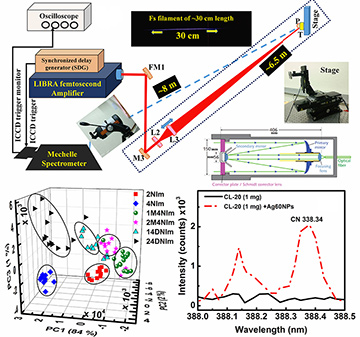 Top: Schematic of standoff femtosecond FIBS setup for investigating explosives (at approximately 6.5 m to 8 m). Bottom left: Principal-component score plots of FIBS data of molecules of explosive compounds. Bottom right: CN peak in FIBS spectra of CL-20 trace in the presence of silver nanoparticles. [Enlarge figure]
Top: Schematic of standoff femtosecond FIBS setup for investigating explosives (at approximately 6.5 m to 8 m). Bottom left: Principal-component score plots of FIBS data of molecules of explosive compounds. Bottom right: CN peak in FIBS spectra of CL-20 trace in the presence of silver nanoparticles. [Enlarge figure]
Detection and identification of explosives and their precursors are imperative to counter worldwide insurgent activities. Though several lab-based techniques exist that are sensitive enough to detect explosive residues, these cannot provide real-time analysis and are specific to molecular bond, structure or moiety. Furthermore, sample collection from hazardous areas is unsafe for the operator. Thus considerable research has focused on developing methods for analyzing samples of interest in standoff mode, with the operator and systems at safe distance.
Both the miniaturization of lasers and improvement in field-deployable instrumentation such as telescopes and beam-delivering optics have made laser-induced breakdown spectroscopy (LIBS), among other laser-based spectroscopic techniques, a widely acknowledged method for detecting chemical and biological agents and explosive residues using well-designed handheld, portable and standoff systems, as well as for analyzing them in situ in real time.1 But while these systems, using nanosecond pulses, can investigate standoff targets at distances up to approximately 100 m, they suffer from issues such as beam wandering and intensity distortion after long-distance propagation.2
We have recently worked with methods that, rather than using nanosecond pulses, employ femtosecond filaments, which can deliver higher intensities at desired remote locations with relatively lower degradation in the beam profile. Recently, we were able to discriminate a set of six molecules of explosives at around 6.5 m,3 as well as several metals and bimetallic targets,4 using femtosecond filament-induced breakdown spectroscopy (FIBS) in tandem with principal-component analysis (PCA). Furthermore, we also were able to detect a 1-mg trace of the nitroamine explosive compound CL-20 spread on brass target in the presence of silver nanoparticles using femtosecond FIBS.
The ablation efficiency of femtosecond filaments is lower, as the energy reservoir of the pulse is spread out, and thus provides weak signal strength. The use of an intensified charge-coupled device (iCCD), however, connected with spectrographs providing high gain, can detect weak signals and therefore be employed for multi-element detection.
We believe that our work, which constitutes a proof of concept for investigating bulk/trace explosives with femtosecond filaments, extends the promise of real-time standoff detection. Moreover, the variable onset of filamentation, control of filament length through chirp, and possibility of generating self-healing filaments with vortex or Bessel beams, combined with mitigated substrate contribution in femtosecond filament interaction, could offer additional flexibility and attractiveness for some applications.5
Researchers
Abdul Kalam Shaik and Venugopal Rao Soma, ACRHEM, University of Hyderabad, Hyderabad, Telangana, India.
References
1. B. Sallé et al. Spectrochim. Acta B 62, 739 (2007).
2. J.J. Laserna et al. Opt. Express 17, 10265 (2009).
3. A. Kalam et al. OSA Continuum 2, 554 (2019).
4. A. Kalam et al. Opt. Lett. 43, 18 (2018).
5. S.S. Harilal. et al. J. Anal. At. Spectrom. 31, 1192 (2016).
